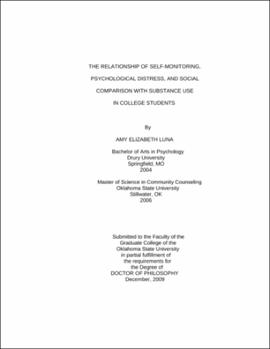| dc.contributor.advisor | Winterowd, Carrie | |
| dc.contributor.author | Luna, Amy Elizabeth | |
| dc.date.accessioned | 2013-11-26T08:34:42Z | |
| dc.date.available | 2013-11-26T08:34:42Z | |
| dc.date.issued | 2009-12 | |
| dc.identifier.uri | https://hdl.handle.net/11244/7491 | |
| dc.description.abstract | Scope and Method of Study: | |
| dc.description.abstract | The purposes of this study were to determine the relationship of self-monitoring and social comparison with substance use in college student and the contribution of social comparison and self-monitoring to substance use, above and beyond what is contributed to by psychological distress as well as explore substance use risk group differences in social comparison, self-monitoring, and psychological distress. Participants for the study included 337 undergraduate students at a southwestern university. They completed the Social Comparison Scale, the Self-Monitoring Scale, the Depression Anxiety Stress Scale-21, the Simple Screening Index-Substance Abuse, the Adolescent Alcohol and Drug Involvement Scale, and the Life Events Scale for Students. | |
| dc.description.abstract | Findings and Conclusions: | |
| dc.description.abstract | Substance use among college students was significantly related to self-monitoring and psychological distress, but not significantly related to social comparison. Psychological distress was significantly related to social comparison and self-monitoring. Of interest, social comparison was not significantly related to self-monitoring. Self-monitoring and social comparison predicted 7.1% of variance in substance use. However, self-monitoring was the only significant predictor. When the relationship between substance use and psychological distress was accounted for, social comparison and self-monitoring uniquely predicted 5.3 % of variance in substance use. College students who were classified as being at risk for a substance use disorder reported more efforts to monitoring one's self-expression in relationships with others, more negative evaluations of self in comparison to others, and more psychological distress compared to college students who were classified as being at minimal risk for a substance use disorder. However, when the effects of gender and race were accounted for, there were no significant differences between substance use risk groups on social comparison. | |
| dc.format | application/pdf | |
| dc.language | en_US | |
| dc.rights | Copyright is held by the author who has granted the Oklahoma State University Library the non-exclusive right to share this material in its institutional repository. Contact Digital Library Services at lib-dls@okstate.edu or 405-744-9161 for the permission policy on the use, reproduction or distribution of this material. | |
| dc.title | Relationship of self-monitoring, psychological distress, and social comparison with substance use in college students | |
| dc.contributor.committeeMember | Boswell, Donald | |
| dc.contributor.committeeMember | Harrist, Steve | |
| dc.contributor.committeeMember | Fuqua, Dale | |
| osu.filename | Luna_okstate_0664D_10551.pdf | |
| osu.accesstype | Open Access | |
| dc.type.genre | Dissertation | |
| dc.type.material | Text | |
| dc.subject.keywords | self-monitoring | |
| dc.subject.keywords | social comparison | |
| dc.subject.keywords | substance use | |
| thesis.degree.discipline | Educational Psychology | |
| thesis.degree.grantor | Oklahoma State University | |
